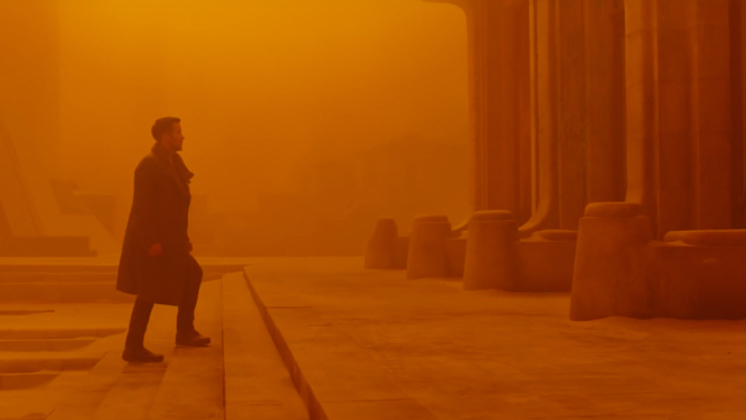
Minor spoilers ahoy.
Blade Runner 2049 is getting ridiculously high ratings, which disturbed me because people like a lot of crap I don’t like and I’m in general agreement with these ratings. What to do? Subconsciously (or not), a lot of the praise may be from the visuals, which isn’t an off-the-mark assessment since films are a primarily visual storytelling medium, and these visuals are apparent in the trailers and such. To that end, the cinematography is perfection; every shot is a perfect cut diamond-angle shot of beauty, and director Denis Villeneuve lets those diamond-visuals breathe by not spraying dialogue and distracting you from feeling the moment. This might be the reason for its 265 minute length: cutting it down to the talky, expositional scenes would make it more compact but far less better to look at.
Set 30 years after the original, there are newer-better-stronger waves of replicants (artificial humans) that have been created, legally, after they had been banned for some time. Ryan Gosling, doing the best (and appropriate to the role) resting asshole face for nearly the entire movie, is a replicant working for the LAPD, who hunts down expired replicants and retires—kills—them. Why a kill switch was never installed in these replicants when they are manufactured is never explained, to my knowledge. The explanatory text in the beginning states that the newer replicants have an open-ended lifespan, but that doesn’t excuse the creators for not implanting a “die immediately, sucker” function, controlled by authorities, that will off a wayward replicant from a safe distance. I’m sure a writer could come up with a good technical reason for the switch’s nonexistence.
The plot, aside from this setting, isn’t a new nut: there’s mysterious box found buried at an expired replicant’s property, and it holds secrets that could “blow the whole thing wide open” if it were made public. This is standard fare for thrillers, but its sci-fi patina absolves Hampton Fancher
and Michael Green, the screenwriters, from wrongdoing. Being connected in every way to the original no doubt helps with this absolution. As lauded as the original Blade Runner was, it was still a gumshoe-noir caper set in the future. I disagree that it “explored what it means to be human,” any more than The Maltese Falcon did, and that’s not bad, and I disagree that a film has to be “deep” to be good, or even enjoyable. Blade Runner stylishly plopped you down in this possible scenario with some really realistic androids and let the audience figure out the philosophical implications. That’s probably the preferred way, if a writer or director wants to go that route, to ask fundamental questions than explicating it like we’re born yesterday*.
Here we go, about that philosophy. There was one scene that really injected a thematic point, out of nowhere it seemed to me, that showed a rallying of unretired replicants to “gain acceptance” in wider human society. We are lead to believe, as modern cinema goes, that replicants are stand-ins for whichever oppressed demograhic the viewer feels fills that role in the real world. This plot element actually demonstrates something about stories in general, and cinema specifically: that stories hijack the human’s installed empathy firmware to create an emotional attachment to an unreal person. Film is much more devious in this way because we have the sight and sound of real humans on screen to dial the effect’s signal strength. The characters on screen aren’t human, they are simply images and sounds of humans doing human things, but our brains’ system processes under the hood haven’t been oriented to consciously distinguish between senses that pick up on humans within our immediate physical plane, and humans elsewhere. We know a film’s event aren’t real, logically, but our empathy centers don’t don’t travel those circuits to pick up on that information, which is why we can feel sympathy for, for instance, victims of a natural disaster upon hearing even basic news about them. We recreate the possible disaster scenario in our imagination centers, not unlike a movie running in our heads, and establish an attachment to how someone might feel in that scenario. Again, logically-speaking, the scenario may not even be close to what actually happened, but our sentiments don’t parse and don’t care; they need to attach themselves to something, and this imagination-movie is the closest thing available. In this same way, replicants can use this phenomenon in their struggle, because with replicants there is no uncanny valley as, aside from an odd personality and a small number visible underneath their bottom-right eyelid, they are indistinguishably close to real humans as anything else.
*This was kind of a pun on replicants being “born” as ostensible adults. I couldn’t really make it funny or fully sensible.